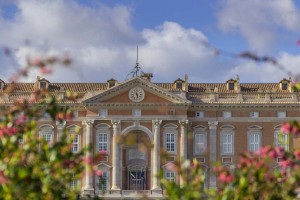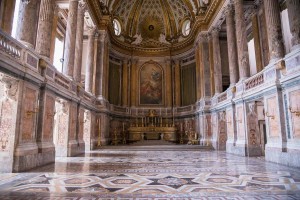
©Bigstock.com/vololibero
The charming town of Caserta in northern Campania awaits you around 40 km north of Naples. It is home to a genuine gem that even Hollywood loves. The baroque Royal Palace built in the 18th century is a magnificent architectural masterpiece that originally served as the Bourbon residence for the kingdoms of Naples and Sicily. It was declared UNESCO World Heritage Site in 1997, together with its tremendous, equally impressive park. This site is a peculiarity as it also includes the formal industrial district San Leucio and the water supply facility Aqueduct of Vanvitelli – a unique mix that is worth exploring.
How the Bourbons came to Naples
The death of King August II in 1733 led to a dispute over the Polish succession to the throne, which caused the War of the Polish Succession from 1733 in 1738. Even though military conflicts, particularly in Poland, Italy and at the river Rhine, had already been settled by 1735, formalities of the succession plan delayed the signing of the Treaty of Vienna by another three years. Charles VII, son of the Spanish king, was given the kingdoms of Naples and Sicily. He was the first regent in 230 years to actually move his residence to the kingdom. As he felt Naples lacked the representative character necessary, Charles chose to have a planned town of sorts built as his residence. Works on the palace town in today’s Province of Caserta commenced.
Luigi Vanvitelli, the king’s architect of choice, was originally commissioned to restore the Basilica della Santa Casa in Loreto under papal instruction, but still moved on to work for the king. The final draft was presented on 22 November 1751, constructions began in the same year. It would take close to 100 years until completion which Vanvitelli’s son Carlo being among his fathers successor. Charles VII, however, only rarely visited the palace. He acceded to the Spanish throne in 1759 becoming Charles III and left the construction site to his eight-year-old son Ferdinand, who would reign over the later extended kingdom, with a brief Napoleonic interlude, until his death in 1825.
A tour of the monumental structure

©Bigstock.com/mkos83
Charles VII had two awe-inspiring palaces on his “wish list”: Palacio Real in La Granja (Spain) and the astonishing Palace of Versailles. The style of La Granja, particularly that of its gardens, was employed to remind Charles of his Spanish homeland, to which he eventually returned much earlier than expected. There over 1,200 rooms and 1,970 windows in the rectangular royal palace with lateral lengths of 247 and 184 m. Triumphal-arch-like portals adorn the sides facing the town and the garden. Financial reasons led to the abandonment of plans for a cupola over the central block and the wing on the town-facing square. Still, this site impresses tremendously.
Even though the baroque Royal Palace of Caserta was altered multiple times over the course of the last two centuries, you will still see numerous original elements of its construction period. The rooms live and breathe primal spirit with old furniture. The taste of the respective design periods becomes palpable in the different rooms allowing you to see highly different furnishing styles back-to-back and door-to-door. Among the must-sees are the Old and the New Apartment with their lavishly decorated rooms and painting collections, the Royal Apartments hidden behind three grand halls and the palace chapel that was modelled closely after the one in Versailles. Don’t miss out on the art gallery with its Bourbon portraits and the Museo Vanvitelliano with pieces from the palace’s long and illustrious history!
If one or the other room happens to look familiar, you probably love going to the cinema. Some of the rooms inside the palace were used for “Star Wars: Episode I – The Phantom Menace” and the Dan Brown adaptation “Angels & Demons” starring Tom Hanks and Ewan McGregor. Nowadays, the palace isn’t just a sight and film location, it also serves as a place of education. The technical school of the Italian Air Force is situated in the southwest part of the park, while the national administration college has its own branch here as well.
The astonishing park
Over 100 hectares of park are part of the ostentatious palace. Charles VII departed from his liking for Versailles to transport a piece of his Spanish homeland to his kingdom. The long vista of the baroque mountain garden is an astonishing three kilometres and filled with wonderous water attractions. Numerous cascades and waterfalls bring aesthetic charm to the park and level the sloping ground.
Countless fountains, richly decorated with nymphs, dragons and statues, accompany your foray through the park. How about the Fountain of the Dolphins, surrounded by three massive dolphin statues built on rocks? Or the Fountain of Diana and Actaeon with its astonishing waterfall flanked by 14 huntresses and hunters? Or the imposing Fountain of Aeolus, originally lined with 54 statues of which 23 are still left? Or… or… well, where to begin? The English Garden might be an option. It is a genuine hidden gem in a sea of water attractions with its collection of rare, exotic plants.
Aqueduct of Vanvitelli
All of these fountains, basins and waterfalls needed a lot of water, but water was a rare commodity in this region. Luigi Vanvitelli built the so-called Caroline Aqueduct, also known as the Aqueduct of Vanvitelli, to collect the water from various springs in the surrounding region and transport it to Caserta. The route from the springs of Fizzo is 38 km long with the perfectly preserved section at Valle di Maddaloni being a true architectural marvel and, as such, a key part of this UNESCO World Heritage Site.
San Leucio
Charles VII wasn’t only a patron of the fine arts; he also tried his hand at experiments. The former site of the hunting castle of the Acquaviva family was turned into a silk fabric with a workers’ village modelled after the latest findings in terms of productivity, innovation and fulfilment of workers’ needs. Ferdinand even wanted to turn it into a fully-fledged planned town, but the French invasion ended such ambitions prematurely. Still, the use of the most modern technology of its time turned San Leucio into an important industrial site of the late 18th and beginning 19th century. The living silk museum grants insights into the revolutionary production methods of this era.
Impressive baroque art, amazing garden aesthetics and revolutionary garden architecture accompany you through this cleverly extended, unbelievably fascinating UNESCO World Heritage Site. Caserta is always worth a visit and makes ostentatious history palpable.